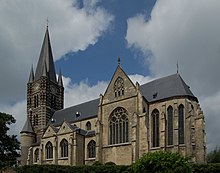Thorn Abbey
The abbey church in Thorn in the Netherlands , a Gothic cruciform basilica mainly from the fourteenth century, served as the collegiate church of the Thorn monastery until the aristocratic women's monastery was abolished in 1797 and since then has served as the Roman Catholic parish church of St. Michael.
Building history and building description
Thorn Abbey was founded in 975 by Bishop Ansfried as a Benedictine monastery.
In the substructure of the westwork of the church, parts of a Romanesque building from the twelfth century have been preserved. The tower is flanked on the lower floors by two round stair towers; the southern of the two round towers was rebuilt in its entire visible structure during the restoration of the church between 1860 and 1881 under the direction of Pierre Cuypers , the same applies to the superstructure of the main tower.
Access to the church is via a portal on the north side, next to which, seen from the outside, on the right from the fifteenth century, there is an archive chamber and above a low vault on the ground floor is the chapter house. In the southern transept, on the other hand, the 'princely choir' or 'ladies' choir' has been preserved in an elevated position, accessible from the nave via a rich staircase. The women's choir has Louis-Seize equipment; it was located in the immediate vicinity of the abandoned abbess palace next to the church.
The choir is designed as a high choir with a crypt underneath . In the crypt there is a mummified corpse ('Mummy of Thorn') in a glass sarcophagus. Like the ladies' choir, the high choir is decorated in the Louis-Seize style, whereas the rest of the interior has neoclassical stucco .
After the abbey was abolished in 1797, the old parish church adjacent to the abbey church was demolished and the abbey church served as a parish church from then on. During the Second World War, the church was damaged in 1944.
Imperial monument
Like many other buildings in Thorn, the Abbey Church of St. Michael in Thorn has been granted the status of a Dutch imperial monument (Rijksmonument, no. 35.490).
Furnishing
Of the other rich furnishings of the church, in addition to several baroque altars, a renaissance altar from 1624 and the high altar from 1769 are noteworthy, as well as a font from the fifteenth century, the late Gothic calvary and an epitaph for the canon Clara Elisabeth von Manderscheid-Blankenheim .
organ
The organ case dates from the 18th century. It was built by Jean-François le Picard from Luik (Belgium). The historic organ (25 stops with an attached pedal ) was destroyed in the Second World War. Today's organ was built in 1951 by the organ builder Vermeulen (Weert). The instrument has 25 registers (including 2 transmissions from the Hauptwerk to the pedal) on three manuals and pedal. The actions are electro-pneumatic.
|
|
|
|
|||||||||||||||||||||||||||||||||||||||||||||||||||||||||||||||||||||||||||||||||||||||||||||||||||||||||||||||||||||||||||||||||||||||||||
- Coupling : II / I, III / I, III / II, I / P, II / P, III / P
photos
Web links
- Monument number: 35490 In: Rijksdienst voor het Cultureel Erfgoed (Dutch)
Individual evidence
- ^ Dutch website on Pierre Cuypers, there in the list of the complete works (Complete lijst van werken van Pierre Cuypers)
- ↑ More information about the organ (Dutch)
Coordinates: 51 ° 9 ′ 38 " N , 5 ° 50 ′ 31" E







